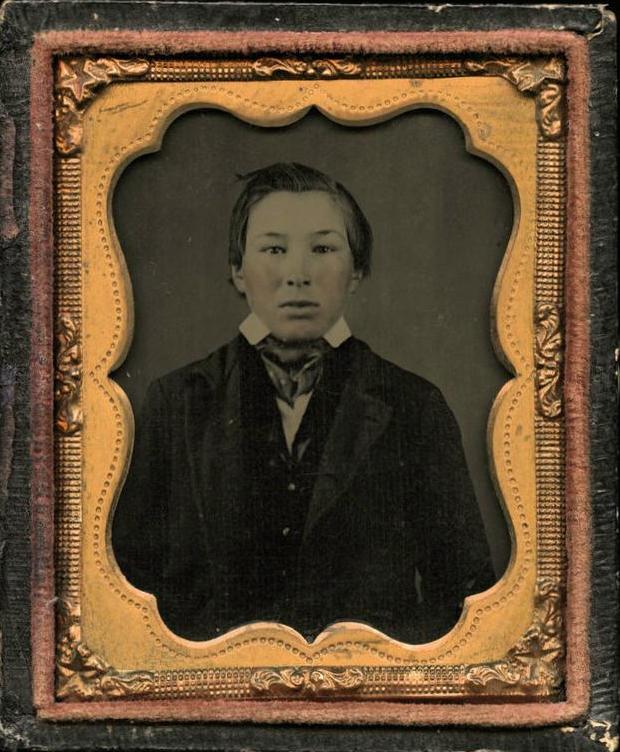
Native American Tribes: Penobscot

Figure 1.--This is a rare Ambrotype of a Native American boy. It is a ninth-plate (1/9) ambrotype of an Americanized Native American Indian boy. His hair cut short and he is dressed in a suit. Given the location, he was likely a Penobscot boy who attended a local Indian school. On the back of the ambrotype is a note in period pencil that reads:
'Taken by George Ulmer in Thorndike Maine (?) St. Harmon Corner (?) / 1857'.
|
|
The Penobscot are an Eastern woodland tribe inhabiting what is now coastal Maine and contunue to live there today. The modern Penobscot are today associated with the Passamaquoddy. Historically they were associated with the Abenaki people who inhabited a substantial area of what is now Maine.
Source: The Penobscot along with several other related tribes (Mi'kmaq, Maliseet, Passamaquoddy, and Abenaki) formed the Wabanaki Confederacy, to resist their traditionl enemies--the Iroquois. The allied tribes inhabitefd the cpoastal regions of what is now Maine. They spoke related languages which suggests deeper dthnic and cultural relationships. The names of the Abenaki and Wabanaki come from the same Algonquian root--"people from the east". The name Penobscot comes from 'panawahpskek'-- 'the place of the white rocks' or 'where the rocks widen'. The Wabanaki Confederacy united the enemies of the Iroquois, especially the Mohawk. As a result, the Penobscot sided with the French and Algonquins in the French and Indian War (1754-63) against the English and Iroquoians. The Penobscot
suffered significantly in the war. The English paid out bounties for killing Penobscots. As with most other Native american peopl, it was European diseases (particulrly smallpox) that proved the most deadly result of European contact. As aesult more than 75 percent of the tribe perished. Animosity with the British resulted with the now much smaller Penobscot tribe siding with the Americans in the Revolutionary War (1776-83).
The Penobscot signed a Treaty with the new Amnerican Republic. They were a rare exeption to the Indian Renoval Act (1830). As a result, were allowed to live on a reservation created from part of their ancestrial lands. They and the allied Passamaquoddy live there now.
The Penobscot were a hunter gathering people. They developed technologies to hunt, trap, and fish. The Penobscot spoke an Algonquin language spoken by the Abenaki people. This was no longer possible when the state of Maine during the 19th century seized much of the Penobscot land and sold it. This included the traditional hunting grounds vital to the traditional life style. The Penobscot thus turned to a variety of cradts to make a living, including basketry nd bead work. They were able to commercislize their canoe msking skills. They also began settled farming..
The Passamaquoddy and Penobscot people have pursued the issue of their treaty rights in the Federal courts. The Tribe received a settlement of $81 million for lost land (1980). The Penobscot used part of the settlement to purchase back some of their land. They are today a sovereign nation attempting to maintain their traditions, language, and self-sufficiency, a difficult undertaking for such a small group.
HBC

Navigate the Boys' Historical Clothing Web Site:
[Introduction]
[Activities]
[Biographies]
[Chronology]
[Clothing styles]
[Countries]
[Bibliographies]
[Contributions]
[FAQs]
[Glossaries]
[Images]
[Links]
[Registration]
[Tools]
[Boys' Clothing Home]
Navigate the Boys' Historical Clothing ethnic pages:
[Return to the Main eastern woodland cultural area page]
[Return to the Main cultural area page]
[Return to the Main Native American ethnic page]
[Return to the Main tribal page]
[Return to the Main ethnic page]
[German]
[Greek]
[Irish]
[Scottish]
Navigate the Boys' Historical Clothing Native American pages:
[Ethnic]
[Dance]
Created: 9:49 AM 9/9/2011
Last updated: 9:49 AM 9/9/2011



